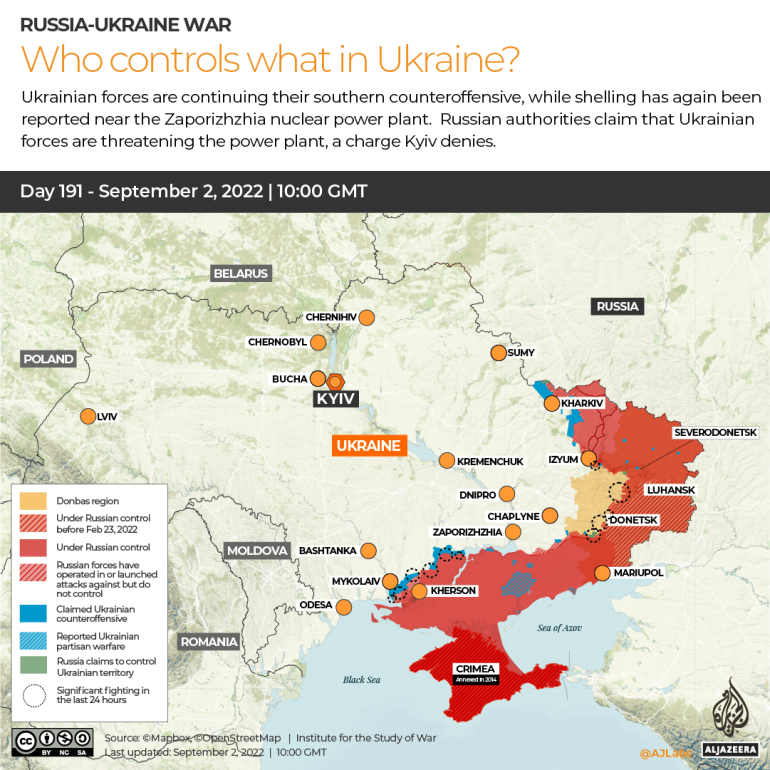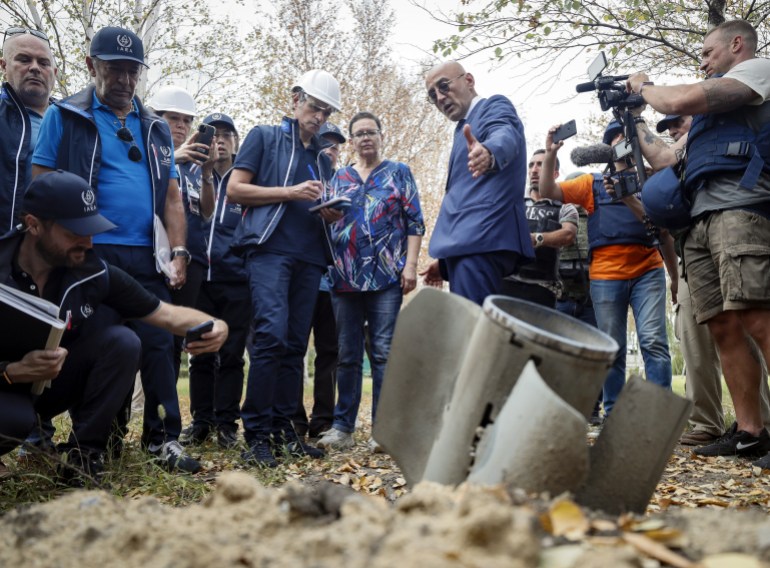Fog of war: Ukraine’s counteroffensive against Russian forces
Both sides have claimed battlefield victories in the initial days of what Ukrainians described as a potential turning point in the war.

Ukraine’s counteroffensive to recapture the first major city to fall to Russia, Kherson, continues as its forces attacked command posts and Moscow’s troops retaliated with a ground assault to stymie the operation.
Ukraine’s southern command spokesperson, Natalia Humeniuk, said Ukrainian troops destroyed ammunition depots and pontoon bridges to hamper the movement of Russian reserves.
Keep reading
list of 4 items‘A big blow’: Mikhail Gorbachev died shocked by Ukraine war
Russia-Ukraine war: List of key events, day 191
UN team ‘not going anywhere’ after visiting Ukraine nuclear plant
Gunfire could be heard near the city centre of Kherson, according to local media reports.
“Our successes are convincing and soon we will be able to disclose more information,” said Humeniuk.
Moscow has denied reports of Ukrainian military progress and said its troops routed Kyiv’s forces.
The Ukrainian army is releasing little news on the progress of the counteroffensive it launched at the start of the week in the Kherson region.
It reported two links used by the Russians to cross a river had been hit. The bridges are significant for resupplying Russian forces to the west of the Dnieper river, on which Kherson lies.
Both sides have claimed battlefield successes in the initial days of what Ukrainians described as a potential turning point in the war.
Zero gas flows
Meanwhile, Ukraine’s general staff on Friday said Russian forces had shelled dozens of cities and towns including Kharkiv – Ukraine’s second-largest city – in the north and the Donetsk region in the east.
Since Russia’s February invasion, more than seven million people have fled Ukraine, thousands have been killed, and cities reduced to rubble in what Kyiv and the West call Russia’s “unprovoked war of aggression”.
Moscow calls its actions a “special military operation” to halt NATO’s expansion in surrounding countries, rid Ukraine of nationalists and protect Russian-speaking communities.
The developments on Saturday came as Moscow and Kyiv traded blame over actions at the Russian-occupied Zaporizhzhia nuclear power plant, where United Nations inspectors arrived on Thursday on a mission to help avert a radiation catastrophe as the facility has repeatedly been attacked.
Turkish President Tayyip Erdogan told Russian President Vladimir Putin in a phone call his country can play a facilitator role regarding the Zaporizhzhia nuclear plant.
Vladimir Rogov, a pro-Russian official in the Zaporizhia region, said Ukrainian forces shelled Europe’s largest nuclear plant several times, and the main power line to the station was downed, forcing it to use reserve power sources, as occurred last week.
Russian energy giant Gazprom, meanwhile, has delayed resuming gas deliveries, a move deepening Europe’s problems securing fuel for winter with living costs already surging.
Nord Stream 1, which runs under the Baltic Sea to supply Germany and others, was set to restart operating after a three-day halt for maintenance on Saturday, but the pipeline operator reported zero flows hours later.
Moscow has blamed sanctions, imposed by the West after Russia’s February 24 invasion of Ukraine, for hampering routine operations and maintenance of Nord Stream 1.
‘Most serious situation’
A UN inspection team, led by International Atomic Energy Agency (IAEA) chief Rafael Grossi, braved intense shelling to reach the Zaporizhzhia plant.
“This is not the first time that an IAEA team has gone into a situation of armed hostilities,” said Tariq Rauf, the organisation’s former head of verification and security, noting the IAEA sent inspectors to Iraq in 2003 and to the former Soviet Republic, Georgia, during fighting.
“But this situation in Zaporizhzhia, I think it’s the most serious situation where the IAEA has sent people in ever, so it’s unprecedented.”
Grossi, after returning to Ukrainian-held territory, said the physical integrity of the plant had been violated several times. A report was expected early next week and two IAEA experts are staying on at the plant for the longer term.
“There were moments when fire was obvious – heavy machine guns, artillery, mortars at two or three times were really very concerning, I would say, for all of us,” Grossi said of his team’s journey through an active war zone to reach the plant.

‘Demilitarise the station’
The situation is further complicated by the Russian occupation of the nuclear power station. The site sits on the south bank of a huge reservoir on the Dnieper river, 10km (six miles) across the water from Ukrainian positions.
Each side has accused the other of shelling near the facility, which is still operated by Ukrainian staff and supplies more than one-fifth of Ukraine’s electricity in peacetime. Kyiv also accuses Russia of using it to shield its weapons, which Moscow denies. Russia has so far resisted international calls to pull troops out of the plant and demilitarise the area.
Ukrainian President Volodymyr Zelenskyy urged the IAEA team to go further than inspections and report writing.
“Unfortunately we haven’t heard the main thing from the IAEA, which is the call for Russia to demilitarise the station,” Zelenskyy said in a video.

Commando-style raid?
Russian defence minister Sergei Shoigu said Ukraine was continuing to use weapons from its Western allies to shell the plant. He rejected assertions by Kyiv and the West that Russia had deployed heavy weapons at the plant.
Several towns near the plant came under Russian shelling on Thursday, a regional council mayor, Mykola Lukashuk said.
Rogov, the pro-Russian official, said Ukrainian forces shelled Enerhodar, the Russia-held town near the power station. He repeated accusations that Ukraine mounted a commando-style raid on the facility with speedboats on the river. Ukrainian officials dismissed that as a fabrication.